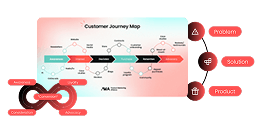Data is valuable because it gives us proof that the universe we are using to craft our story is the right one. We often hear that we should start our pitch with either a story or a number. I understand the directive, and I’ve used it many times, but that’s just where the real work starts.
Numbers themselves should tell a story. Even if we find the largest number that would make it a no-brainer to purchase, it might not move my customer.
For example, globally, analytics consulting alone reached $43 billion in 2017, showcasing the growing reliance on data-driven insights. Is that a lot? We have no idea.
43 billion tells us nothing, and the analytics consulting industry in this particular case is just as irrelevant. That is the issue, right?
Because every time we try to start a success case with a customer, even if they are a multinational company with thousands of employees, they tend to be clueless as to what to measure or how to do it.
They have zero idea how much money they were losing to the problem, or how many hours, or what the process looks like.
So, how do I craft compelling content when they don’t even know what their problem is?
The thing about content is, the more precise it is, the more it triggers an action. You can’t be vague and expect results. You need to show people exactly what matters and why.
There’s a reason in retail they say, “Stack it high, watch it fly”. You put your best seller on display, not your personal favorite. The same applies here. You lead with the strongest proof you have, not with what you think sounds smart or what you want your best seller to be.
So, where are product marketers getting that kind of information from? Let’s go from the easiest to the hardest.
External data sources
External data sources are great for super small or one-person teams by grounding your narrative in concrete evidence:
- Market trends that validate your direction
- Financial penalties companies face for non-compliance
- Time savings potential when addressing specific challenges
- Revenue figures that demonstrate business impact
They are also great for super large teams, where you have specialized product marketers focusing on different areas, and you can have someone looking at the outside.
For these kinds of data points, Perplexity.ai is a gem. I’ve been using it to get reliable sources on market data. The same can be said for Statista (paid) and the premium versions of GPT (not my favorite).
Klue is a fantastic upgrade from Google Alerts and Hubspot, enabling us to create battlecards, be updated on competitive intelligence, and send out quality weekly newsletters easily.
Crayon is better if you need to track a lot of competitor activity across the web and want a broader, automated intel feed for multiple teams. Klue is stronger if your main focus is sales enablement and you want to deliver curated battlecards that reps actually use.
Crayon is more about monitoring, Klue is more about activation. If you already know your key competitors and want to support reps in live deals, go with Klue. If you’re still mapping the landscape or want intel beyond sales, Crayon makes more sense.
Finally, Gartner and Statista (100,000k upwards) can be great. They provide industry information and beat anything, though each seat is very costly, and having someone doing analyst relations might consume their whole daily bandwidth, too.
The intel you can get from them, especially for up-and-coming or extremely competitive industries, cannot compare to any other free data source.
Gathering internal data to put salt on the wound
When you’re working in a company that’s past its early days, you usually have enough going on internally to start pulling real insights. This is where things start getting interesting. You just need to know where to look and how to connect the dots.
First, you can go to your sales tools. The CRM is the easiest place to start. It tells you who is buying, when, and through which channel. You can look at ticket size, region, industry, client size, and start spotting patterns.
Maybe your biggest deals all come from a certain partner or campaign. Maybe clients who came in through a webinar are way more loyal. This is where you check what worked, so you can do more of that.
Most companies use Hubspot or Salesforce, but use what you have. If that is connected to a data lake and a BI tool such as Power BI, congratulations, you hit the jackpot.
If you have a SaaS, then you can have product usage data. This is what people actually do once they’re in the tool. If you have access to analytics or behavior tracking tools, you can see where users spend most of their time, what reports they export, and what features are most clicked. It shows what really matters to them.
If you don’t have any, jump through hoops and do whatever you need to get them installed. Tools like Mixpanel, Amplitude, or even Hotjar are helpful here. Some product teams also pull this data directly from their backend if they have good internal support.
On top of that, you have all the content your customers and team interact with. Start with the knowledge base.
- What are the most viewed articles?
- Which ones have the lowest helpful rating?
- What are people searching for?
That tells you what they need and what they’re not finding. If you’re using something like Intercom or Zendesk, those insights are usually one click away.
Then, look at the tools your team uses to find answers. I’ve used Guru in the past and I love it. You can see which cards people view, how often, and what they search for. It’s a great way to know what sales and support teams are being asked, even if the question never reaches product or marketing.
Others I’ve seen use Confluence, Notion, or even internal Google Docs (all these have terrible analytics, and I’m sorry for you if your company uses them). You just don’t get the same level of tracking unless it’s something built for enablement.
Next, conversations. If your company records calls, you’re sitting on a goldmine. Tools like Grain or Gong let you search past calls, get summaries, and extract quotes from actual clients.
Gong is the gold standard, but Grain has been a good pick for global teams because, unlike many others, it supports multiple languages, at a fraction of the cost of Gong.
This is where you hear how people actually describe their problems and what words they use to explain their needs. That’s the language you want to mirror in your content. You also get a feel for who’s involved in the decision. Who do they report to? Who do they mention? What do they complain about? That tells you how to position your message and whom to aim it at.
Finally, reviews. If you’re not looking at G2 or Gartner Peer Insights, you’re missing out. Reddit is also a content goldmine where your users are very likely offloading their issues without a filter. People are saying in public what they like and what they wish were better.
Read your reviews. Read your competitors’ reviews. Look for repeated phrases or common frustrations. That’s where your messaging should go. It’s not just for the website, it helps shape your pitch and even your product roadmap. Social proof still beats any fancy copy, so use it. Do you have a user community?
We are building one now and cannot decide between Gainsight and BetterMode for this very reason: we need insights, people. The era for tools that don’t give you insight is over.
The goal here isn’t to collect everything. It’s to listen. If you look across all these sources and start connecting what you see, you’ll find the real story behind the product. And that’s what people will remember.
If you are a fast monkey such as myself, export everything to a Google Sheets doc and ask ChatGPT to help you with the pivot tables. Once you get the hang of them, they’re simple.
Pivot tables help you connect different data sets using a common field, like linking company size from Hubspot with webinar attendees by customer ID. They always need a shared reference point. So remember to use the same identifying field across tools.
Walking the walk
Map the user journey to uncover the story. You can’t write around what you don’t understand. If the data is incomplete or unclear, you’ll have to dig. That’s the job. Strategy built on real input takes time, but it’s the only way to get content that actually moves someone.
If you don’t have the perfect number, look for patterns. If you don’t have the quote, go back to the calls. There’s no skipping this part when the internal data is weak.
As someone once told me, if you can’t get there with your head, get there with your feet. In content, that means do the work until the insight shows up.


















 Follow us on LinkedIn
Follow us on LinkedIn




.svg)
Start the conversation
Become a member of Product Marketing Alliance to start commenting.
Sign up now